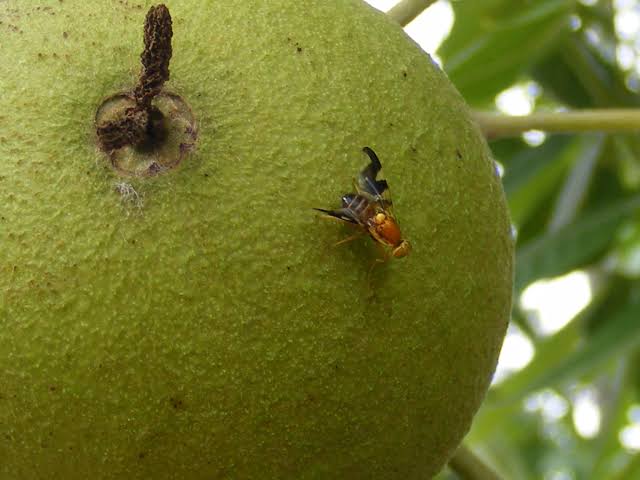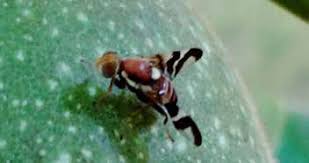The Walnut Husk Fly, scientifically known as Rhagoletis completa, is a small insect that can significantly impact walnut crops. This tiny fly, measuring only a few millimeters in length, plays a crucial role in the ecology of walnut trees. Let’s delve into the fascinating world of the Walnut Husk Fly and explore its life cycle, behavior, and the challenges it poses to walnut orchards.
This particular species of fly is notorious for its association with walnut trees, primarily targeting the husk that surrounds the developing walnut fruit. The female Walnut Husk Fly lays its eggs on the surface of the husk during the late spring or early summer months. Upon hatching, the larvae burrow into the husk, causing damage to the developing walnuts.
The life cycle of the Walnut Husk Fly is closely intertwined with that of the walnut tree. The larvae feed on the husk, consuming its nutrients as they grow. As they reach maturity, the larvae exit the husk and drop to the ground, where they pupate in the soil. The pupal stage is a critical period of transformation for the Walnut Husk Fly before it emerges as an adult ready to restart the cycle.
The impact of Walnut Husk Fly infestations on walnut orchards can be significant. The damage caused by the larvae feeding on the husk can lead to premature nut drop, reducing the overall yield of the walnut crop. Additionally, the entry points created by the larvae provide opportunities for pathogens to enter the developing walnuts, further compromising the quality of the harvest.
Efforts to manage Walnut Husk Fly populations often involve integrated pest management strategies. These may include the use of pheromone traps to monitor fly activity, the application of insecticides at specific times during the fly’s life cycle, and cultural practices aimed at disrupting the insect’s reproductive cycle.
The Walnut Husk Fly, with its scientific name Rhagoletis completa, is a noteworthy participant in the intricate dance of nature within walnut orchards. Understanding its life cycle and behavior is crucial for farmers and researchers seeking to mitigate its impact on walnut crops. As agriculture continues to grapple with the challenges posed by various pests, the Walnut Husk Fly stands out as a tiny yet significant player in the delicate balance between human cultivation and the natural world.
Read Also: 15 Medicinal Health Benefits Of Aspidosperma quebracho-blanco (Quebracho Blanco)
Plants Affected by Walnut Husk Fly (Rhagoletis completa)

The Walnut Husk Fly (Rhagoletis completa) primarily affects walnut trees, particularly the common walnut tree species, Juglans regia. This insect has a specific affinity for the husk that surrounds the developing walnuts on these trees. The female Walnut Husk Fly lays its eggs on the surface of the husk, and the subsequent larvae feed on the husk, causing damage to the developing walnuts.
The impact of Walnut Husk Fly infestations is particularly significant for walnut orchards, where the quality and yield of the walnut crop can be compromised. The larvae’s feeding activity within the husk can lead to premature nut drop, affecting the overall productivity of the walnut trees.
It’s worth noting that while the Walnut Husk Fly has a primary association with walnut trees, its impact is not limited to these trees alone. The interconnected nature of ecosystems means that the presence of Walnut Husk Fly can have indirect effects on other plants and organisms within the surrounding environment. Managing and understanding the dynamics of this insect is crucial for maintaining the health and productivity of walnut orchards and the broader ecological balance in affected regions.
Damages Caused by Walnut Husk Fly

The Walnut Husk Fly (Rhagoletis completa) can cause significant damages to walnut orchards, impacting both the quality and yield of the walnut crop. The damages primarily stem from the feeding activities of the Walnut Husk Fly larvae on the husk that surrounds the developing walnuts. Here are some key aspects of the damages caused by the Walnut Husk Fly:
1. Premature Nut Drop: The larvae of the Walnut Husk Fly burrow into the husk of developing walnuts, feeding on the tissue. This feeding activity weakens the husk, leading to premature nut drop before the walnuts are fully mature. This premature dropping of nuts reduces the overall yield of the walnut crop.
2. Quality Degradation: The entry points created by the Walnut Husk Fly larvae provide pathways for pathogens, fungi, and bacteria to enter the developing walnuts. This can result in infections and diseases, further compromising the quality of the nuts. Infested walnuts may exhibit discoloration, mold, and other signs of decay.
3. Economic Impact: Walnut growers may experience economic losses due to reduced yields and lower-quality nuts. The damages caused by the Walnut Husk Fly can lead to increased production costs as growers invest in pest management strategies to mitigate infestations and maintain crop health.
4. Harvesting Challenges: The premature dropping of nuts due to Walnut Husk Fly infestations poses challenges during harvesting. Growers may need to adapt their harvesting practices to account for the early nut drop, affecting the efficiency of harvesting operations.
Efforts to manage the damages caused by the Walnut Husk Fly often involve a combination of cultural practices, biological controls, and chemical interventions. Integrated pest management strategies aim to reduce the impact of this insect on walnut orchards while minimizing environmental impact and maintaining sustainable agricultural practices. Understanding the life cycle and behavior of the Walnut Husk Fly is crucial for implementing effective control measures to mitigate damages and preserve the health of walnut crops.
Read Also: 10 Medicinal Health Benefits Of Astrocaryum aculeatissimum (Tucum)
Control and Preventive Measures

Controlling and preventing Walnut Husk Fly (Rhagoletis completa) infestations is essential for maintaining the health and productivity of walnut orchards. Here are some common control and preventive measures employed by growers to manage Walnut Husk Fly populations:
1. Pheromone Traps: Deploying pheromone traps helps monitor Walnut Husk Fly activity. These traps use synthetic chemicals that mimic the insect’s sex pheromones, attracting and trapping adult flies. Monitoring the population helps growers time interventions effectively.
2. Timed Insecticide Applications: Applying insecticides at specific times in the Walnut Husk Fly life cycle is a common strategy. This often involves targeting the adult flies during their emergence or the larvae during their feeding stage. Careful timing is crucial to maximize efficacy and minimize environmental impact.
3. Cultural Practices: Implementing cultural practices that disrupt the Walnut Husk Fly life cycle can be effective. This may include practices such as removing fallen nuts promptly to reduce overwintering sites for pupae, and pruning trees to improve air circulation, making the orchard less favorable for the fly.
4. Biological Controls: Encouraging natural predators and parasites of the Walnut Husk Fly can be a sustainable approach. Some parasitic wasps and predators feed on the eggs, larvae, or pupae of the fly, helping to keep populations in check.
5. Sanitation Measures: Keeping the orchard clean by removing fallen nuts, debris, and damaged fruit can reduce the available breeding sites for the Walnut Husk Fly. Sanitation measures aim to disrupt the insect’s life cycle and limit its ability to reproduce.
6. Cultural Timings: Coordinating orchard activities with the Walnut Husk Fly life cycle is crucial. For example, timing nut harvests to minimize exposure to egg-laying adults and coordinating pest management practices with key developmental stages can enhance control efforts.
7. Resistant Varieties: Some walnut varieties may exhibit natural resistance to Walnut Husk Fly infestations. Growers may choose to plant varieties that are less susceptible to the insect, contributing to a more resilient orchard.
Integrated pest management, combining multiple strategies, is often the most effective approach to control Walnut Husk Fly populations while minimizing the impact on the environment. Regular monitoring, adapting strategies to local conditions, and staying informed about the latest research and technologies contribute to successful pest management in walnut orchards.
Frequently Asked Questions (FAQs) About Walnut Husk Fly (Rhagoletis completa)
1. Q: What is the Walnut Husk Fly?
A: The Walnut Husk Fly (Rhagoletis completa) is a small insect known for its association with walnut trees, particularly the common walnut species, Juglans regia. The fly’s larvae feed on the husk surrounding developing walnuts, causing potential damage to the crop.
2. Q: How does the Walnut Husk Fly damage walnut crops?
A: The larvae of the Walnut Husk Fly burrow into the husk of developing walnuts, leading to premature nut drop. This can reduce the overall yield and quality of the walnut crop. The feeding activity also creates entry points for pathogens, affecting the health of the nuts.
3. Q: When is the Walnut Husk Fly active?
A: The activity of the Walnut Husk Fly typically peaks during late spring or early summer when adult flies lay their eggs on the walnut husk. Understanding their life cycle helps in implementing effective control measures.
4. Q: What are the signs of Walnut Husk Fly infestation?
A: Signs include premature nut drop, discolored or damaged husks, and potential mold or decay in infested walnuts. Monitoring the orchard and inspecting nuts can help identify early signs of infestation.
5. Q: How can growers monitor Walnut Husk Fly populations?
A: Pheromone traps are commonly used to monitor adult fly activity. These traps attract and capture the flies using synthetic chemicals that mimic their sex pheromones.
6. Q: What are effective control measures for Walnut Husk Fly?
A: Control measures include timed insecticide applications, cultural practices like sanitation and pruning, biological controls, and the use of resistant walnut varieties. Integrated pest management combines these strategies for optimal results.
7. Q: Can Walnut Husk Fly infestations be prevented?
A: While complete prevention may be challenging, adopting preventive measures such as sanitation, monitoring, and timely interventions can help minimize the impact of Walnut Husk Fly infestations.
8. Q: Are there natural predators of the Walnut Husk Fly?
A: Yes, certain parasitic wasps and predators feed on the eggs, larvae, or pupae of the Walnut Husk Fly. Encouraging these natural enemies can contribute to biological control in walnut orchards.
9. Q: How does the Walnut Husk Fly affect the economy of walnut production?
A: Walnut Husk Fly infestations can lead to economic losses due to reduced yields and lower-quality nuts. Growers may incur additional costs for pest management strategies and face challenges during harvesting.
10. Q: Are there ongoing research efforts to address Walnut Husk Fly issues?
A: Yes, ongoing research aims to develop more effective and sustainable control methods, understand the biology of the Walnut Husk Fly, and identify resistant walnut varieties to mitigate the impact on crops.

